ALL THE LATEST UPDATES FROM THE DUMFRIES AND GALLOWAY PUBLIC PROTECTION PARTNERSHIP
Dumfries and Galloway Public Protection Partnership is a multiagency group responsible for the oversight development and delivery of services to the most vulnerable children and adults who are at risk of or experiencing harm.
If you have a question relating to any of the content you read today, please reach-out to the team using one of the contact methods at the end of the newsletter.
The 8th edition of the DGPPP newsletter features a special spotlight article on the NHS Dumfries and Galloway Public Protection Team.

WE NEED YOUR HELP TO STOP VIOLENCE AGAINST WOMEN AND GIRLS
Violence against women and girls is common in most societies and Dumfries and Galloway is no different.
Unfortunately, violence against women and girls is one of the most prevalent human rights violations in the world (UNFPA) and most of it is not reported or recorded. The United Nations suggests as many as 1 in 3 women experience some type of abuse in their lifetime (WHO) and this is directed at them because they are women.
In 2020-21, there were 65,251 domestic abuse incidents recorded by Police Scotland and in 80% of all cases a woman was abused by a man. There were 1,615 cases reported in D&G in the same period.
|
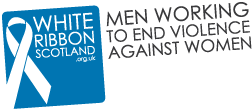
The White Ribbon Campaign started in Canada in 1991 as a response for men to challenge men’s violence against women (VAW). It is now operating in many countries across the globe, including Scotland. Supporters of White Ribbon (WR) take a pledge ‘never to commit, condone or remain silent about violence against women in all its forms.’
Wearing a white ribbon is a public demonstration that the wearer has taken this pledge, does not excuse violence against women and is committed to supporting community action to stop men’s violence against women and to achieve gender equality. Men of all ages, from all workplaces, political affiliations and backgrounds are encouraged to help establish community responses to stop violence against women.
All men who want to identify as an ally to women survivors of violence against women are encouraged to sign the pledge.
Click HERE to make your pledge.
Other ways to help are by:
- Offering to be part of the new White Ribbon Steering Group in Dumfries and Galloway. This will require committing to attend overview training (1.5 hours) and attend regular Group meetings to direct WR activity locally. These meetings will be monthly for the first 3 months and it is expected meetings will move to quarterly thereafter.
- Become a White Ribbon Champion – this is for people with influence for example, senior managers or leaders in sports groups. Training will be provided (1.5 hours).
- Train as a White Ribbon Speaker (with a commitment to raise awareness of White Ribbon and Violence Against Women at agreed events). Training will be delivered by White Ribbon Scotland staff. Module 1 is: 'What is VAW' and 'Why Should Men be Involved and what Can They Do?' It takes 3 hours. Module 2: 'The Background to White Ribbon' and 'Bystander Theory’. The session takes 2.5 hours.
If you are interested in being involved as a Steering Group member, Speaker or Champion, please contact: domesticabuse@dumgal.gov.uk
|
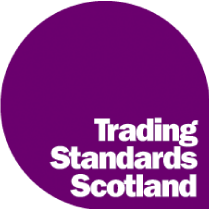
SCOTS WARNED OF SCAMS RELATING TO COST OF LIVING CRISIS
Trading Standards Scotland has launched a month-long campaign aimed at raising awareness of scams linked to the ongoing cost of living crisis. As prices and bills continue to rise, many consumers will have financial worries heading into autumn and winter. Scammers may attempt to exploit these anxieties and to target people online and via cold calls, emails and text messages in an attempt to obtain their personal details and bank account information.
Email and text scams connected to the energy bill rebate and cost of living payments have already been reported, as well as fake supermarket voucher and fuel card giveaways on social media.
Doorstep scammers have been giving householders misleading information about grants and funding for energy efficiency measures such as boilers and insulation, while some rogue traders have taken advantage of the global shortage of construction materials to ask customers to pay large deposits, then failing to return to carry out the work.
There have also been reports of dangerous electric devices being sold online which claim to save money on energy bills – consumer safety charity Electrical Safety First recently tested some of these products and found that they all failed basic safety tests, posing the risk of fire or electric shock.
Those worried about making ends meet are also being warned to be wary of online adverts offering ‘quick and easy’ loans or cryptocurrency investment opportunities with supposedly high returns. These adverts often imply that the investment has been endorsed by celebrities such as Martin Lewis.
|
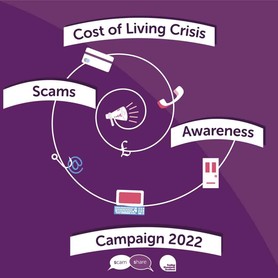
Trading Standards Scotland recently ran the Big Scottish Scam Survey, asking Scots about the scams they had experienced in the last year.
97% of respondents had experienced an email, text, phone, doorstep or online scam in the last year. For those who lost money to a scam, the amounts ranged from £37 to £25,000.
Some of the most common scams were:
- Delivery scams
- HMRC scams
- Amazon scams
- Energy scams
- Covid Scams
- Prize draw/giveaway scams
- Bank scams
- Remote access scams
- Online shopping scams
- Rogue traders
79% of survey respondents had avoided a scam after seeing or reading about it, with 41% going on to report the scam.
Cllr Maureen Chalmers, Chair of Trading Standards Scotland’s Governance Board, said:
“Since the beginning of the Covid pandemic, we have seen how quickly scammers can adapt to changing circumstances to take advantage of people’s financial worries.
“Unfortunately, as we move into the autumn and winter months, scammers are increasingly likely to target people who are worried about paying their bills and who may be more likely to click on links or respond to messages offering discounts on bills or investment opportunities.
“We are delighted to be working with partners across the UK to run this month-long awareness campaign, through which we hope to provide consumers with the knowledge and tools they need to say no to scammers.
“We would like to remind consumers to be wary of cold callers, unsolicited emails and text messages and online adverts offering deals, discounts and giveaways. Never accept information offered from these sources without doing independent research, and don’t provide any personal or financial information to a cold caller or via a link in an unsolicited message.
“We are also asking people to look out for family members, friends and neighbours who may be vulnerable and to share messages about scam awareness with them.”
Further information about the campaign can be found at https://www.tsscot.co.uk/cost-of-living-scams/
Scams should be reported to Advice Direct Scotland on 0808 164 6000 or through their website: www.consumeradvice.scot
|

THROW LINE TRAINING FOR LOCAL BUSINESSES
Over the past few months, Dumfries and Galloway Community Action Team have received Waterside Responders Scheme training, provided by PAWS (Partner Agency Water Safety Group) in partnership with the Royal National Lifeboat Institution. This has allowed Scottish Fire and Rescue Service Dumfries and Galloway to engage and deliver throw line training to 6 local businesses and their staff, this will allow them to respond and support the SFRS to the key areas across Dumfries and Galloway.
|
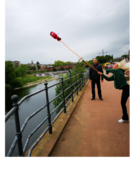
Each business that has supported the SFRS Dumfries and Galloway scheme has been provided with a free throw line. These scheme members are now able to respond to an event on the River Nith and Loch Ken, Castle Douglas. The Scottish Fire and Rescue Service continues to look for local businesses in key areas to offer free Water Side Responder Schemes to support communities in Dumfries and Galloway.
|

SAFE AND TOGETHER MODEL OVERVIEW TRAINING
What are the plans for S&T in Dumfries and Galloway?
Dumfries and Galloway has received funding from the Delivering Equally Safe Fund to bring the Safe and Together approach to our region. One of the strengths of the Safe & Together Model is to provide a shared language and approach and improve cross system collaboration. We are welcoming our partners across Dumfries and Galloway to join us so that we can support the development of a shared approach to this complex and challenging issue.
What issues does Safe & Together aim to address?
Traditionally survivors, usually mothers, have been held responsible for the impact of domestic abuse on their children. There has been a tendency to focus on their decision making, rather than the perpetrator’s pattern of coercive control, as being the primary risk and safety concern for children. Often there are expectations that they will show that they are protective by carrying out drastic actions which significantly impact the child and family functioning, like moving home, ending the relationship or calling the police. Often our systems fail to see the myriad other efforts they undertake to keep their children safe and provide a stable, nurturing and healing environment. Conversely, there has been a lack of accountability for perpetrators in our systems; both as domestic abuse perpetrators and for their role as fathers in families. Without a shared approach to this complex issue, cross system collaboration is challenging and our siloed responses fail to provide the outcomes our families need.
These are domestic abuse destructive practices defined as policies and practices that actively harm adult and child survivors of domestic abuse or make it harder for them to access support and assistance.
The Safe & Together Model: Creating Domestic abuse informed practice and systems.
The Safe & Together Model aims to help change the conversation about how we work with families impacted by domestic abuse perpetrator’s behaviours. It is an internationally recognised suite of tools and interventions designed to help child welfare professionals become domestic abuse-informed. Continuously refined through years of experience of implementing the Model globally this evidence-based practice can help improve competencies and cross-system collaboration. The Safe & Together Model, as a systems change framework, offers language, thinking and practices that help increase accountability for perpetrators as parents, reduce victim blaming and improve outcomes for children and families.
This child-centred model derives its name from the concept that children are best served when we can work toward keeping them safe and together with the non-offending parent - the adult domestic abuse survivor. The Safe & Together Model provides a framework for partnering with domestic abuse survivors and intervening with domestic abuse perpetrators in order to enhance the safety and wellbeing of children.
Training in Safe & Together has been undertaken in just under 80% of Scottish Local Authorities and it is being widely adopted across the UK, Australia and the United States.
To find out more about Safe & Together, please watch this short clip
HOW TO APPLY
Please email SafeandTogether@dumgal.gov.uk to register your interest.
|
💡 SPOTLIGHT ARTICLE 💡

MEET THE NHS DUMFRIES AND GALLOWAY PUBLIC PROTECTION TEAM
Public Protection is a central theme in the work of health services as well as Social Services and Police Scotland. The wider public services also include Fire & Rescue as well as 3rd sector partnerships.
Public Protection is everyone’s business and maintains a high public profile. A growing proportion of a health staff’s daily work is being taken up by the 5 R’s of Public Protection - Recognising, Responding, Referring, Recording and Reflecting as health staff assess and manage risk in order to protect and support our more vulnerable children and adults.
Who are we?
The NHS Dumfries and Galloway Public Protection Team comprises of thirteen team members and is led by a Nurse Consultant who reports directly to the Director of Nursing. The Nurse Consultant is supported by a Senior Public Protection Advisor, 3 Child Protection Advisors, 5 Public Protection Advisors, 1 Administrator and 2 Administration Assistants.
|
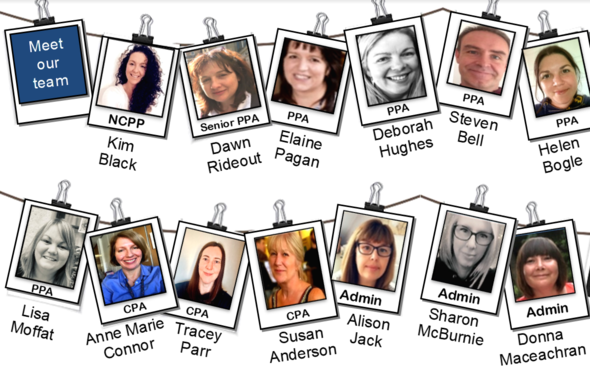 What do we do?
The Core Functions of the Public Protection Team are to:
- Provide expert advice and support to all NHS Staff who have professional & statutory duties relating to Child Protection and Adult Support & Protection including a duty to refer to Social Work when there is concern about a vulnerable child or adult.
- Partake in Interagency Referral Discussions (IRD’s)
- Provide child protection supervision
- Attend relevant child/adult protection meetings
- Deliver single and multi-agency public protection training
- Undertake Learning Reviews.
- Represent the NHS within the Wider national and local Public Protection Partnership
- Comply with Duty to Co-operate functions within MAPPA-Multi Agency Public Protection Arrangements (high risk offenders), Adult Support & Protection legislation and PREVENT (terrorism prevention)
- Contribute to the development of public protection multi and single agency policies and procedures.
What do staff in NHS Dumfries and Galloway Public Protection Team say about their role?
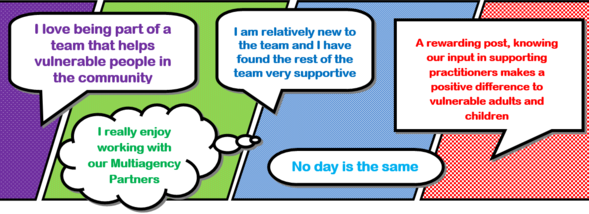 What do NHS staff say about our team?
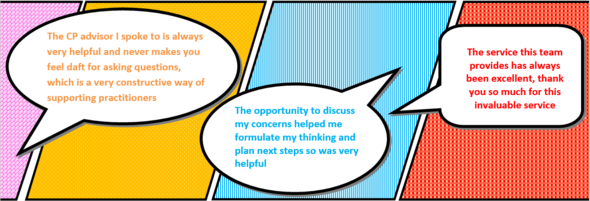
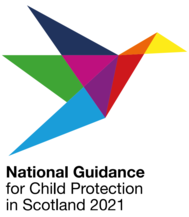
UPDATE - LOCAL IMPLEMENTATION OF NATIONAL CHILD PROTECTION GUIDANCE
Dumfries & Galloway Child Protection Guidance Implementation group have met on five occasions since the last update in April 2022.
The May 2022 meeting provided an opportunity to focus on the national position regarding implementation as Angela Latta, Scottish Government, and Lorrette Nicol, Social Work Scotland, were able to attend to lead the discussion.
The challenges/opportunities Dumfries & Galloway are facing are not dissimilar to other local authorities in Scotland. Key issues being explored include:
- Transitions and the link with adult protection
- 16 - 17-year-olds
- Pre-Birth issues
- Age of Criminal Responsibility (ACR)
The importance of sharing learning with other national sub-groups was also highlighted, thus making links and having parallel streams of work. Transitions, contextual safeguarding, ACR, Bairns Hoose, SCIM, the Promise, are all interconnected.
Achievements to date:
- Communication was circulated towards the end of June 2022 highlighting a further development of the local implementation on the National Guidance, that is, the review of the formatting and facilitation of Child Protection Planning Meetings (CPPM). Not only will this embrace the signs of safety approach, but this also aims to strengthen the resources that exist within families to build safety for children who have suffered, or likely to suffer, significant harm.
A test of change has been developed and in the process of being piloted using the Plan Do Study Act (PDSA) model of improvement. The family and those participants from partner agencies were contacted in advance of the initial CPPM to prepare them for what to expect. All participants were asked to contribute to feedback to not only allow for amendments to be made to the process but also capture the “lived experience” which will be crucial to the success of the development.
It is hoped full implementation will be completed for all initial and review CPPM by late September early October 2022. The multi-agency “Attendance at CPPM” training materials will be revised and rolled out thereafter.
- The July 2022 meeting concentrated on the CP minimum data set report, definitions and updates to categories to align with the National Guidance. Some categories remain the same, some are new, and some have been reworded, for example, “services finding it hard to engage” as opposed to “non-engaging families”.
The challenge is not only adapting these to local child protection IT processes, but also the need to consider the potential updates to Child Protection eLearning training in addition to the already recently reviewed multi-agency child protection training, communicating the changes across the partnership and how to measure outcomes/success post implementation. We will keep you updated regarding progress.
Next steps………
As it is important to ensure implementation captures the process as well as the principles highlighted in the National Guidance, this will be the topic for the next meeting. The principles include:
- Early support
- Children’s Rights and Human Rights
- Parents and carers engagement, what they need
- Recognising context of risk
- Structural inequalities – poverty, neglect, ACE’s
- Interagency training and predictable supervision
We will continue to provide you with regular updates of local progress of implementation via the PP Newsletter and trust you find this useful.
Thank you to everyone who has been involved so far in helping us on this journey.
|
PPC L&D TRAINING PROGRAMME 2022
📚 For more information about multiagency public protection training opportunities CLICK HERE.
|
|
 |

CONTACT
Thank you very much for reading this issue of the DGPPP Newsletter.
💬 If you would like to leave any feedback or contribute to the next Newsletter, please contact publicprotection@dumgal.gov.uk
|
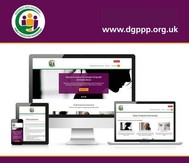
Visit our DGPPP website for resources and latest Public Protection updates.
|
|